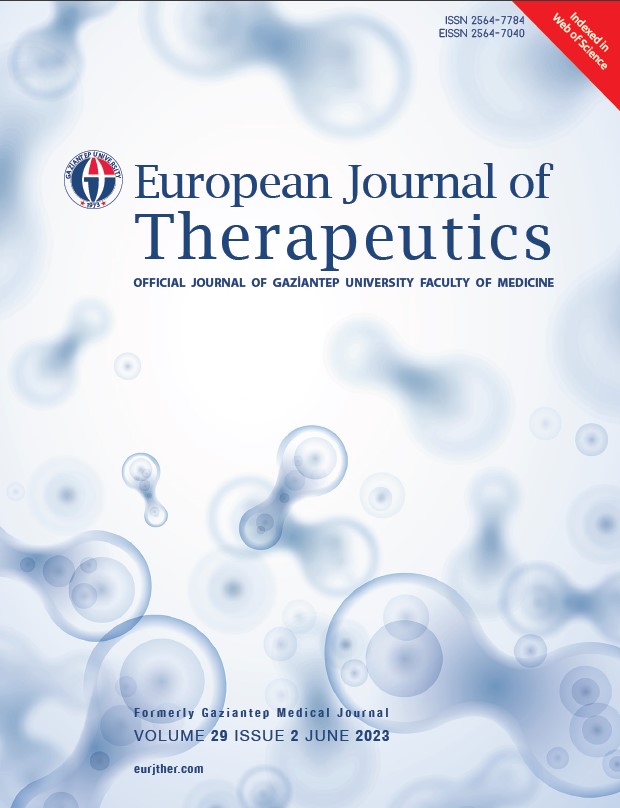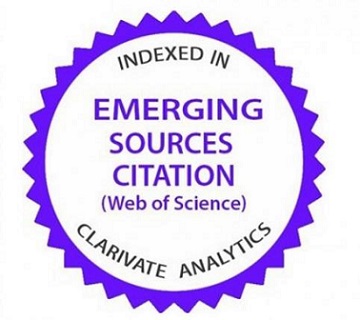Real-Life Data of Neoadjuvant Chemotherapy in Breast Cancer: Aegean Region Experience
DOI:
https://doi.org/10.58600/eurjther.20232902-347.yKeywords:
breast neoplasms, developing countries, neoadjuvant therapy, pathologic responseAbstract
Objective: The use of neoadjuvant chemotherapy (NACT) in breast cancer is increasing. The management of locally advanced breast cancer differs due to the approach of the center to which the patient applied and the approach of the following physician. From this point of view, we aimed to evaluate the real life data of our region.
Methods: The study included 106 patients treated with neoadjuvant chemotherapy in the medical oncology clinic of two different university hospitals. Association between clinicopathological features and pathological complete response (pCR) were analyzed.
Results: The pCR rate was higher in patients with negative hormone receptors and this difference was statistically significant (p:0.000). The rate of obtaining pCR increased as the NACT duration increased, and this increase was statistically significant. The mean NACT duration applied to the patients with pCR was 5.48 ± 0.22 months, and the mean NACT duration for those who could not obtain pCR was 5.01 ± 0.1 months (p:0.041). The recurrence rate of patients with pCR was 11.1%, while the recurrence rate of patients who could not obtain pCR was 31.6% (p:0.04).
Conclusions: Pathological response to chemotherapy is an important factor in determining prognosis. There appears to be a need for new biomarkers that allow the prediction of pCR and long-term outcomes.
Metrics
References
Fitzmaurice C, Akinyemiju TF, Al Lami FH, et al. (2018) Global, regional, and national cancer incidence, mortality, years of life lost, years lived with disability, and disability-adjusted life-years for 29 cancer groups, 1990 to 2016 a systematic analysis for the global burden of disease study global burden o. JAMA Oncol. 4(11):1553–68. https://doi.org/10.1001/jamaoncol.2018.2706
Simos D, Clemons M, Ginsburg OM, Jacobs C. (2014) Definition and consequences of locally advanced breast cancer. Curr Opin Support Palliat Care. 8(1):33–8. https://doi.org/10.1097/SPC.0000000000000020
Cortazar P, Geyer CE. (2015) Pathological Complete Response in Neoadjuvant Treatment of Breast Cancer. Ann Surg Oncol. 22(5):1441–6. https://doi.org/10.1245/s10434-015-4404-8
Cardoso F, Kyriakides S, Ohno S, Penault-Llorca F, Poortmans P, Rubio IT, Zackrisson S, Senkus E; ESMO Guidelines Committee. (2019) Early breast cancer: ESMO Clinical Practice Guidelines for diagnosis, treatment and follow-up. Ann Oncol [Internet]. 30(8):1194–220. https://doi.org/10.1093/annonc/mdz173
T.C. Sağlık Bakanlığı Halk Sağlığı Genel Müdürlüğü. Türkiye Kanser İstatistikleri 2016 [Internet]. Ankara. 2019. Available from: https://hsgm.saglik.gov.tr/depo/birimler/kanser-db/istatistik/Trkiye_Kanser_statistikleri_2016.pdf
Sawaki M, Shien T, Iwata H. (2019) TNM classification of malignant tumors (Breast Cancer Study Group). Jpn J Clin Oncol. 49(3):228–31. https://doi.org/10.1093/jjco/hyy182
Anderson BO, Yip CH, Smith RA, Shyyan R, Sener SF, Eniu A, Carlson RW, Azavedo E, Harford J. (2008) Guideline implementation for breast healthcare in low-income and middle-income countries: Overview of the breast health global initiative Global Summit 2007. Cancer. 113(8 SUPPL.):2221–43. https://doi.org/10.1002/cncr.23844
Güler N, Karabulut B, Koçdor MA, Kaya H, Esen G, Özaslan C, et al. (2011) 2010 İSTANBUL MEME KANSER İ KONSENSUS TOPLANTISI CONSENSUS MEETING. 68–89.
Klein J, Tran W, Watkins E, Vesprini D, Wright FC, Look Hong NJ, Ghandi S, Kiss A, Czarnota GJ. (2019) Locally advanced breast cancer treated with neoadjuvant chemotherapy and adjuvant radiotherapy: A retrospective cohort analysis. BMC Cancer. 19(1):1–11. https://doi.org/10.1186/s12885-019-5499-2
Killelea BK, Yang VQ, Mougalian S, Horowitz NR, Pusztai L, Chagpar AB, Lannin DR. (2015) Neoadjuvant chemotherapy for breast cancer increases the rate of breast conservation: Results from the national cancer database. J Am Coll Surg [Internet]. 220(6):1063–9. http://dx.doi.org/10.1016/j.jamcollsurg.2015.02.011
Rastogi P, Anderson SJ, Bear HD, Geyer CE, Kahlenberg MS, Robidoux A, Margolese RG, Hoehn JL, Vogel VG, Dakhil SR, Tamkus D, King KM, Pajon ER, Wright MJ, Robert J, Paik S, Mamounas EP, Wolmark N. (2008) Preoperative chemotherapy: Updates of national surgical adjuvant breast and bowel project protocols B-18 and B-27. J Clin Oncol. 26(5):778–85. https://doi.org/10.1200/JCO.2007.15.0235
Trudeau M, Sinclair SE, Clemons M. (2005) Neoadjuvant taxanes in the treatment of non-metastatic breast cancer: A systematic review. Cancer Treat Rev. 31(4):283–302. https://doi.org/10.1016/j.ctrv.2005.03.007
Swain SM, Miles D, Kim SB, Im YH, Im SA, Semiglazov V, Ciruelos E, Schneeweiss A, Loi S, Monturus E, Clark E, Knott A, Restuccia E, Benyunes MC, Cortés J; CLEOPATRA study group (2013) Pertuzumab, trastuzumab, and docetaxel for HER2-positive metastatic breast cancer (CLEOPATRA study): Overall survival results from a randomised, double-blind, placebo-controlled, phase 3 study. Lancet Oncol [Internet]. 14(6):461–71. http://dx.doi.org/10.1016/S1470-2045(13)70130-X
Allemani C, Weir HK, Carreira H, Harewood R, Spika D, Wang XS, Bannon F, Ahn JV, Johnson CJ, Bonaventure A, Marcos-Gragera R, Stiller C, Azevedo e Silva G, Chen WQ, Ogunbiyi OJ, Rachet B, Soeberg MJ, You H, Matsuda T, Bielska-Lasota M, Storm H, Tucker TC, Coleman MP; CONCORD Working Group. (2015) Global surveillance of cancer survival 1995-2009: Analysis of individual data for 25 676 887 patients from 279 population-based registries in 67 countries (CONCORD-2). Lancet [Internet]. 385(9972):977–1010. http://dx.doi.org/10.1016/S0140-6736(14)62038-9
Öztürk A, Bozdoğan A, Selamoğlu D, Müslümanoğlu M, İğci A, Özmen V. (2012) Lokal İleri Meme Kanserli Olgularda Neoadjuvan Kemoterapi Sonrasi Hastaliksiz Ve Genel Sağkalimi Etkileyen Faktörler Uzun Dönem Sonuçlarimiz. J Breast Health. 8(3):138–45.
Spring L, Greenup R, Niemierko A, Schapira L, Haddad S, Jimenez R, Coopey S, Taghian A, Hughes KS, Isakoff SJ, Ellisen LW, Smith BL, Specht M, Beverly M, Bardia A. (2017) Pathologic complete response after neoadjuvant chemotherapy and long-term outcomes among young women with breast cancer. JNCCN J Natl Compr Cancer Netw. 15(10):1216–23. https://doi.org/10.6004/jnccn.2017.0158
Ring AE, Smith IE, Ashley S, Fulford LG, Lakhani SR. (2004) Oestrogen receptor status, pathological complete response and prognosis in patients receiving neoadjuvant chemotherapy for early breast cancer. Br J Cancer. 91(12):2012–7. https://doi.org/10.1038/sj.bjc.6602235
Park YR, Lee J, Jung JH, Kim WW, Park CS, Lee RK, Chae YS, Lee SJ, Park JY, Park HY. (2020) Absence of estrogen receptor is associated with worse oncologic outcome in patients who were received neoadjuvant chemotherapy for breast cancer. Asian J Surg [Internet]. 43(3):467–75. https://doi.org/10.1016/j.asjsur.2019.05.010
Downloads
Published
How to Cite
Issue
Section
License
Copyright (c) 2023 European Journal of Therapeutics

This work is licensed under a Creative Commons Attribution-NonCommercial 4.0 International License.
The content of this journal is licensed under a Creative Commons Attribution-NonCommercial 4.0 International License.


















